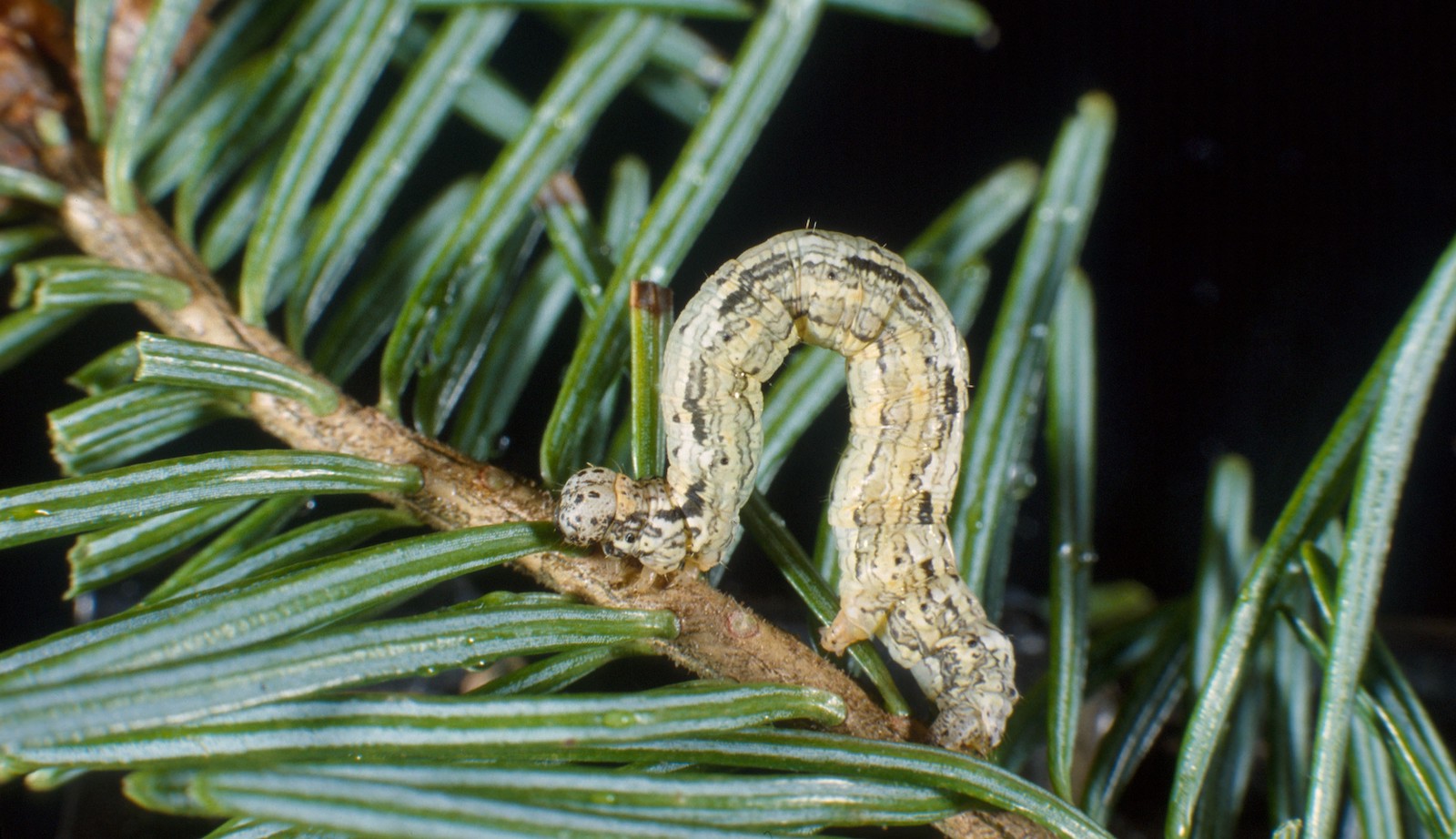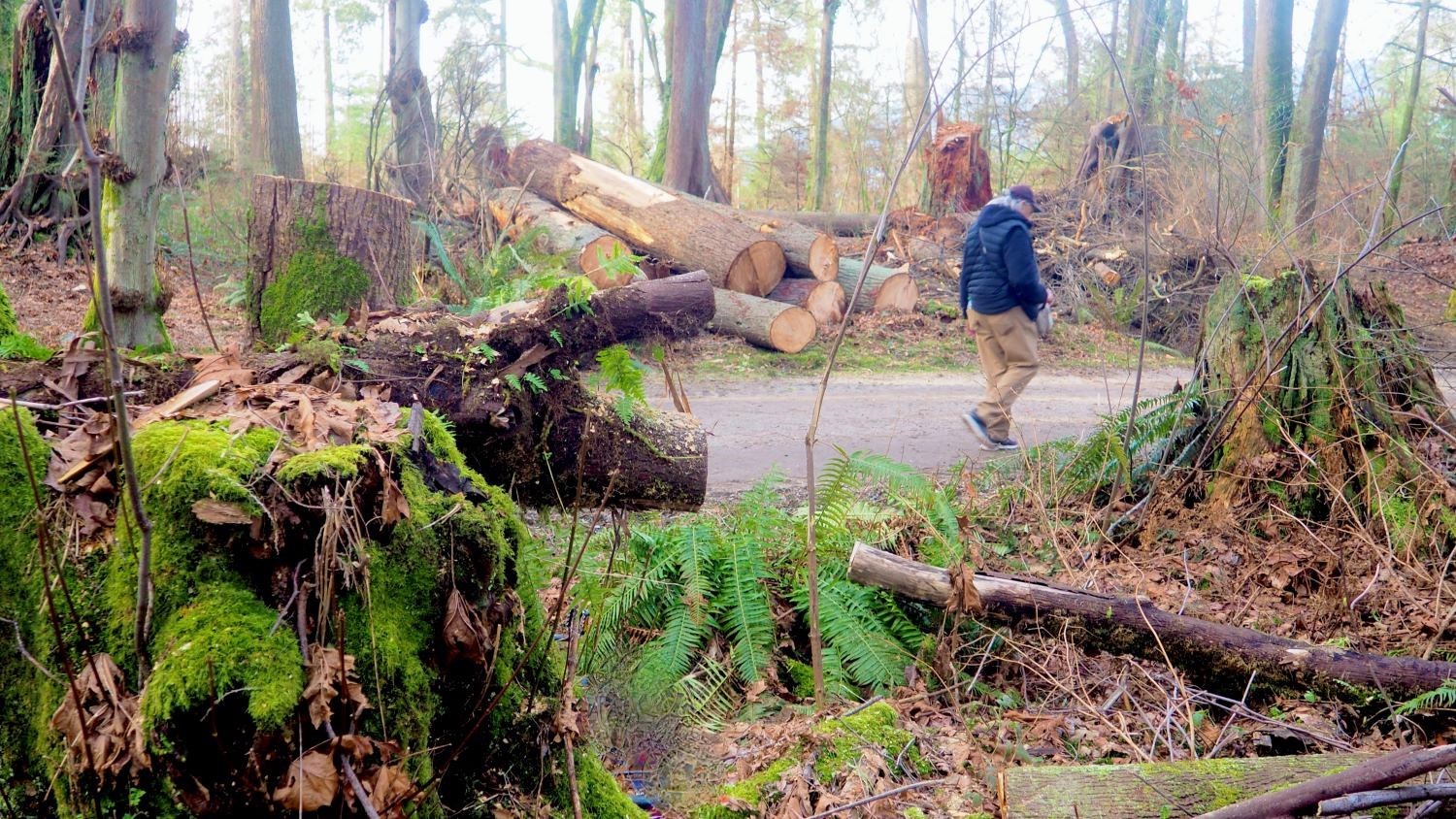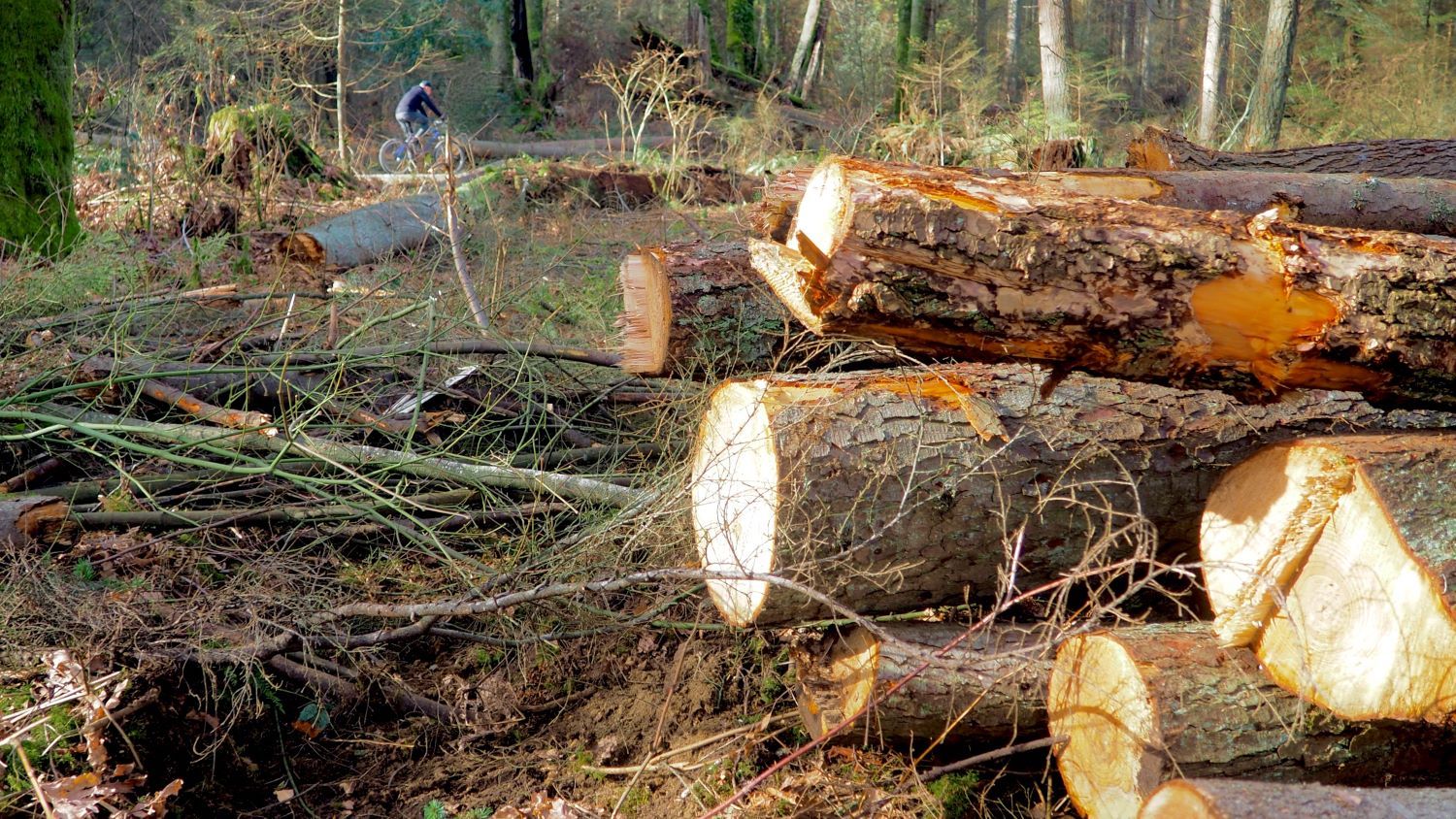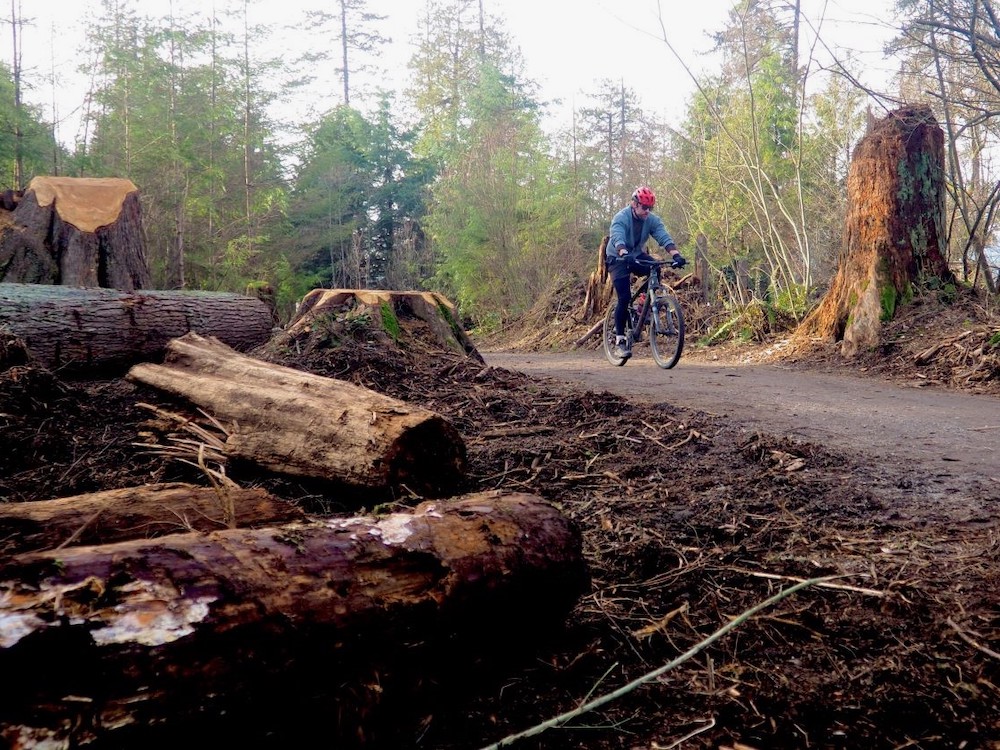For part of its length, Stanley Park's Bridle Trail runs parallel to the Stanley Park Causeway. Not far beyond the pedestrian/equestrian overpass, as I geared down for the uphill pedalling where the trail angles left and begins a long climb on its way toward Prospect Point, I looked to my right, where causeway traffic was moving to and from the Lions Gate Bridge. The traffic was not unusual. What startled me was its visibility. Countless times I had ridden this trail, aware only of muffled sounds beyond the thick stand of trees. Now the space between trail and causeway was almost completely open, save for a few remaining trees, stumps and piles of logs.
Another rider came down the hill toward me. As he passed, he yelled, “Why?”
Joe McLeod knows why. “Probably late 2020, but especially 2021, was when we noticed we're starting to lose trees to the western hemlock looper outbreak,” he says. “We identified that this is not typical of what you would usually see.”
The park board's manager of urban forestry is overseeing the response to the devastating infestations that have now lasted several years, a response that involves cutting thousands of dead and dying trees in the name of keeping humans safe.
For regular habitués of the park the effects can be jaw-dropping. And some have questions. A group calling itself Save Stanley Park has collected over 15,000 names on an online petition at Change.org asking for a halt to the tree culling operations.
On a pleasant Friday afternoon at Lost Lagoon, Michael Robert Caditz and Anita Hansen make the group's case while pausing periodically to hand out leaflets to passersby. “There's two issues,” Caditz says, “the process and the substance of what they're doing.
“The process was very secretive. There was no public review, open debate or input from stakeholders. In the park board's own characterization, it was an operational decision made by staff. It was a backroom process.”
As for the substance, Caditz says, “the most extreme measures were taken without an opportunity for the public, other scientists and stakeholders to advocate for less extreme measures. We want a freeze on logging until we can have transparent hearings.”
Stanley Park is a weird hybrid — large enough to seem like a wild ecosystem, but essentially a well-treed Vancouver neighbourhood. The relative lack of megafauna is a clue that this is no ordinary forest. The only deer to inhabit the park in recent years met a bad end, briefly a tame and well-fed tourist attraction with its own Twitter account as “Downtown Deer,” until its almost inevitable death on the causeway.
Coyotes are the largest four-legged animals in the park, but they too have suffered from human interaction, with 11 handout-habituated animals killed for aggressive behaviour three years ago. Maintaining the park as a public space and refuge has involved challenges, like dealing with the straight-line windstorm of December 2006 that blew down swaths of trees. Shocking as that event was, it has been dwarfed by the scale of the latest crisis.

The current series of looper moth (Lambdina fiscellaria) infestations began on the North Shore before migrating across the water. The toll has been huge. Of the approximately 700,000 trees in Stanley Park, McLeod says, about 160,000 are dead. “The majority of those are hemlocks,” he says.
Champion germinators, hemlocks are far and away the most numerous tree species in the park. It's a banquet for hemlock looper caterpillars, and the little green gluttons are notoriously wasteful consumers. “They're considered messy feeders,” McLeod says, “meaning they don't eat all of the needles of the trees. They just eat the base of the needle, because it's softest and easiest for them to access. The remainder of the needle falls to the ground. They can completely denude a tree within a day or two. Then they hang down on threads and work their way up another tree. In a very quick period they can do a significant amount of damage.”
Ideally, looper outbreaks will eventually be knocked back, either by predators, such as parasitoid wasps and birds, or by weather. “If you have a really wet spring or colder winter, the egg stage of the insect will be interrupted and you won't get the outbreak the following year,” McLeod says.
But weather and predators have not co-operated, and the outbreaks have recurred for several years. In addition to the affected hemlocks, McLeod says, “there's some Douglas fir and cedar.”
Looper moth infestations are nothing new, but management strategies have changed. Once upon a time the preferred response was a pre-DDT pesticide called lead arsenate. Eight tons of it were sprayed over Stanley Park in 1929. It was certainly effective. According to a 2010 report from the Stanley Park Ecology Society, the result was “a two-inch carpet of the hemlock looper caterpillars in the Park.” Aerial dusting continued until the 1960s (and many Vancouver residents will remember the roar of low-flying aircraft spraying Btk over the city to combat Asian spongy moths in 1992).
Was spraying considered this time? “The City of Vancouver has historically moved away from using pesticides and bio-pesticides,” McLeod says. “Our sentiments have changed over the last 30 years.”
The bio-pesticide prescribed in this case was not one that would have targeted loopers specifically. “It would essentially kill all moths and butterflies within Stanley Park,” McLeod says.

In response to the infestation, the city published a request for proposal in April 2022. B.A. Blackwell & Associates was retained in December 2022. “Bruce Blackwell has worked all over the province,” McLeod says. “I would say he's a leader in the wildfire risk community.”
In January 2024, Blackwell & Associates issued a report on its operations. “As of April 2023, approximately 30 per cent of the trees greater than 20 cm in diameter in Stanley Park have been killed or severely defoliated by looper defoliation, and an additional 36 per cent have been moderately defoliated,” the report read. “Removal of dead trees is imperative due to the high risk to human safety and park infrastructure.”
Caditz says this act of public disclosure arrived far too late. “Massive logging operations began many months before the report came out,” he says. “I have filed a freedom of information request — and I'm not the first who's done it — for the original proposal that was accepted by the City of Vancouver, not the January 2024 report. I haven't seen whether there were any proposals besides Blackwell's — I don't know if there was a written proposal at all. It may just have been a verbal deal.
“Was it a foregone conclusion that they were going to accept the proposal from Blackwell? I am suspicious about the lack of documentation and transparency around the process.”
It's important, Caditz believes, because not everyone agrees on the best approach. “I am finding differences of opinion,” he says. “I have talked to foresters and arborists. The old-school forestry approach is to cut down dead trees. But a more progressive approach is that it's very important to leave dead trees standing. If a particular tree is in imminent danger of falling, only then should the tree be cut down. Considering that there are different views — and reasonable people can disagree — there should have been a transparent airing of alternative views.”
One of those alternative views comes from arborist Norm Oberson of Vancouver-based Arbutus Tree Service. Oberson feels the fire risk has been greatly exaggerated. “There's no fire hazard in Stanley Park,” Oberson says, noting that previous lightning strikes and spot fires hadn’t set the park ablaze.
“Leave the dead trees standing,” Oberson says. “Let nature take its course.”
McLeod describes that argument as “patently false.” “Anything to do with wildfires is the domain of registered professional foresters,” McLeod says, “and feedback from professionals is supportive of the approaches we've taken. When dead trees fall to the ground that is dry kindling, that increases your likelihood of a fire.”
He says cutting or at least reducing the height of dead trees reduces risk. “Ladder fuels are essentially dead branches that allow a wildfire on the ground to escalate up into the canopy. Once you get a fire in the canopy, that's where it becomes super dangerous. If you get a wind, that fire can move, not just through the forest, but you can also start seeing embers spanning kilometres. We want to essentially mitigate the wildfire risks, but also the public safety risks.”
Caditz and Hansen insist more public input is needed. “We're not scientists,” Caditz says. “We want to stop everything until the scientists can get together before the public and have a forum with different viewpoints represented. We are prepared to file for an interlocutory injunction from B.C. Supreme Court to temporarily freeze the logging, as a last resort.”

McLeod says prolonged consultation could be fatal to mitigation efforts. “We're tasked with being stewards of the city's trees, which includes 150,000 street trees, 40,000 park and golf course trees and nearly a million trees in forested areas,” he says. “If we had to get public approval for every tree that we remove in the city, we would never get 100 per cent consent. People have emotional attachments to trees, for good reason. At a certain point we have to make clinical decisions. We don't ask to mitigate risk to public safety.”
“We have been in dialogue with First Nations governments, Musqueam, Squamish and Tsleil-Waututh, since July 2022. We've had ongoing feedback. They understand public safety is critical.”
There were other considerations demanding prompt action, McLeod says. “We were constrained by the bird-nesting window, typically between March and September. So the work window when we're not going to impact nests and habitat is September to March. We couldn't lose a full season of mitigation work, because there were so many dead trees.”
Regarding habitat, McLeod says some dead trees are indeed being left standing. “We're leaving stumps that are 10, 15, 20, 30 feet tall in some cases, to provide habitat for cavity nesting birds and other species, but also being mindful that they're not within striking distance of a path.”
The highest-priority area was the causeway area, dealing with the potential for trees to come down on traffic and bike lanes. “There were a lot of moving parts, a lot of work happening with the Ministry of Transportation behind the scenes,” McLeod says. “The necessity of moving forward expeditiously meant that we moved forward with a sole source contract. We didn't have the luxury of time for a competitive process.”
Although a small amount of timber will be sold to defray park board costs, McLeod says no one is profiting from the cull. “Any cedar and Douglas fir is pretty much 100 per cent being shared with First Nations, Musqueam, Squamish and Tsleil-Waututh,” he says.
“There's also a fair amount of hemlock being shared with First Nations for cultural purposes, such as traditional burning, or any building work that they want to do. There is some residual hemlock that is going to a domestic log sort up in Squamish, and from there, it's being channeled appropriately. The best that we could expect from this project from a cost recapture perspective is less than five per cent.”
The next step involves replanting. One goal will be cutting back on the looper food supply. “Hemlock is overrepresented in the park,” McLeod says. “We're going to be replanting with Douglas fir, western red cedar, as well as other species. We've been seeking some feedback from our First Nations partners. And some of that feedback has been compelling us to plant species like Pacific yew, which is, historically, culturally important for local First Nations. There's also interest of having some foraging species like huckleberry, salmonberry, maybe red elderberry and others. Ultimately the goal is to balance the ecology within Stanley Park.”
“Our goal is to mitigate further damage,” says Save Stanley Park's Hansen. “Whether someone did something wrong, that's secondary. We want to find the least damaging solution. That, we think, has not been found.”
Stanley Park may well be described as the emotional heart of Vancouver, a focus of both civic pride and concern. Enclosed by development, trashed by the elements and visitors, human and otherwise, it is an admixture of natural and manufactured elements. This latest in the park's long series of crises comes amid fierce debate, not only about how the park should be managed, but by whom.
Late one recent night, with an ambulance siren wailing through the West End, I heard the answering howls of coyotes from the depths of the park. Three years after the coyote cull, the keening calls coming through my open window were reassuring. Even in an urban environment, nature can be resilient. ![]()
Read more: Municipal Politics, Environment

















Tyee Commenting Guidelines
Comments that violate guidelines risk being deleted, and violations may result in a temporary or permanent user ban. Maintain the spirit of good conversation to stay in the discussion and be patient with moderators. Comments are reviewed regularly but not in real time.
Do:
Do not: